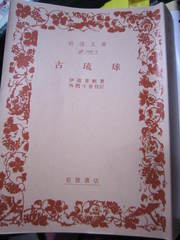
I have to write about Iha fuyu and his influence on Okinawan performing arts after Meiji 39 when he came back to Okinawa graduating from Tokyo University.
It seems to be obvious that he urged Okinawans to be proud of their own history and ancestors emphasizing that Japan and Okianwan languages are based on the same trend as people of Okinawa came down from Kyushu area of Japan. Those called Amamikiyo were the ancestors of Okinawan, so he insists.
He mentions that Omoro is similar to Manyo-shu, and the myth of Okinawa is similar to the myth of Japan written in Kojiki. All these meant to make Okinawans to be positive about being Japanese since 1879.
Omoro is used to identify how much Japanese and Okinawans are related. Iha also says they came from the same ancestors as Japanese religion, Shintoism, is similar to animism of Okinawan ancestral worship.
His passion to relate Okianwans to Japanese is so strong that it makes me intrigue, too.
Well, I have to organize my idea how much his individual thought encouraged those Okianwan performers, too.
One thing is certain that Iha's encouragement of being proud of Okinawans brought some kind of revival of digging into their own history and culture.



















